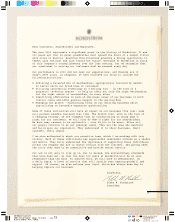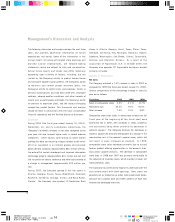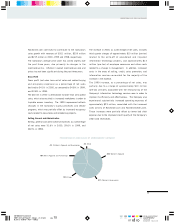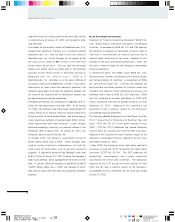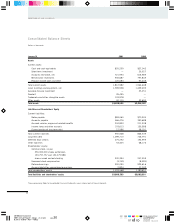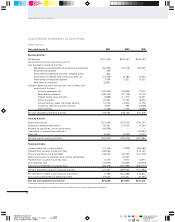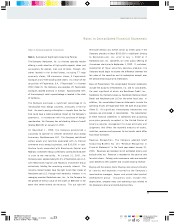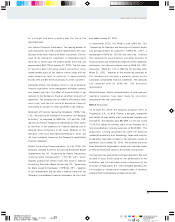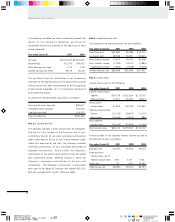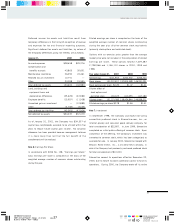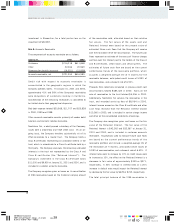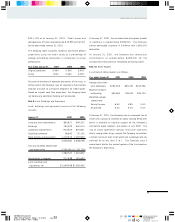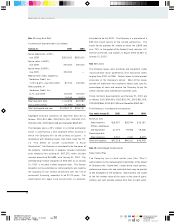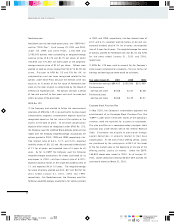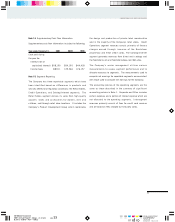Nordstrom 2000 Annual Report Download - page 25
Download and view the complete annual report
Please find page 25 of the 2000 Nordstrom annual report below. You can navigate through the pages in the report by either clicking on the pages listed below, or by using the keyword search tool below to find specific information within the annual report.
Cyan Mag Yelo Blk
20100444 Nordstrom
2001 Annual Report • 44pgs. + 4 covers pg. 23
8.375 x 10.875 • PDF • 150 lpi
PMS
5773
PMS
5503
23
NORDSTROM, INC. AND SUBSIDIARIES
Dollars in thousands except per share amounts
Note 1: Summary of Significant Accounting Policies
The Company: Nordstrom, Inc. is a fashion specialty retailer
offering a wide selection of high-quality apparel, shoes and
accessories for women, men and children, through 120
stores located in the United States, including 77 large
specialty stores, 38 clearance stores, 3 Façonnable
boutiques and 2 free-standing shoe stores. As a result of the
acquisition of Façonnable, S.A. (“Façonnable”) in October
2000 (Note 2), the Company also operates 20 Façonnable
boutiques located primarily in Europe. Approximately 32%
of the company’s retail square footage is located in the state
of California.
The Company purchases a significant percentage of its
merchandise from foreign countries, principally in the Far
East. An event causing a disruption in imports from the Far
East could have a material adverse impact on the Company’s
operations. In connection with the purchase of foreign
merchandise, the Company has outstanding letters of credit
totaling $62,051 at January 31, 2001.
On November 1, 1999, the Company established a
subsidiary to operate its Internet commerce and catalog
businesses, Nordstrom.com LLC. The Company contributed
certain assets and liabilities associated with its Internet
commerce and catalog businesses, and $10,000 in cash.
Venture funds associated with Benchmark Capital and
Madrona Investment Group collectively contributed $16,000
in cash to the new entity. At January 31, 2001, the
Company owns approximately 81.4% of Nordstrom.com LLC,
with Benchmark Capital and Madrona Investment Group
collectively holding the remaining minority interest. The
minority interest holders have the right to sell their shares of
Nordstrom.com LLC, through their ownership interests in its
managing member Nordstrom.com, Inc., to the Company for
the greater of the fair value of the shares or $80,000 in the
event that certain events do not occur. This put right will
terminate without any further action by either party if the
Company provides at least $100,000 in additional funding
to Nordstrom.com, Inc. prior to July 1, 2002 or if
Nordstrom.com, Inc. completes an initial public offering of
its common stock prior to September 1, 2002. If, and when,
redemption of these securities becomes probable, the
Company would begin to accrete the difference between the
fair value of the securities and its redemption amount over
the period remaining prior to redemption.
Basis of Presentation: The consolidated financial statements
include the accounts of Nordstrom, Inc. and its subsidiaries,
the most significant of which are Nordstrom Credit, Inc.,
Nordstrom fsb (formerly known as Nordstrom National Credit
Bank) and Nordstrom.com LLC for the entire fiscal year. In
addition, the consolidated financial statements include the
operating results of Façonnable from the date of acquisition
(Note 2). All significant intercompany transactions and
balances are eliminated in consolidation. The presentation
of these financial statements in conformity with accounting
principles generally accepted in the United States of
America requires management to make estimates and
judgments that affect the reported amounts of assets,
liabilities, revenues and expenses. Actual results could differ
from those estimates.
Revenue Recognition: The Company adopted Staff
Accounting Bulletin No. 101 “Revenue Recognition in
Financial Statements” in the fiscal year ended January 31,
2000. Revenues are recorded net of estimated returns and
exclude sales tax. Revenue is recorded at the point of sale
for retail stores. Catalog and e-commerce sales are recorded
upon delivery to the customer and include shipping revenue.
Buying and Occupancy Costs: Buying costs consist primarily
of salaries and expenses incurred by the Company’s
merchandise managers, buyers and private label product
development group. Occupancy costs include rent,
depreciation, property taxes and operating costs related to
the Company’s retail and distribution facilities.
Notes to Consolidated Financial Statements


